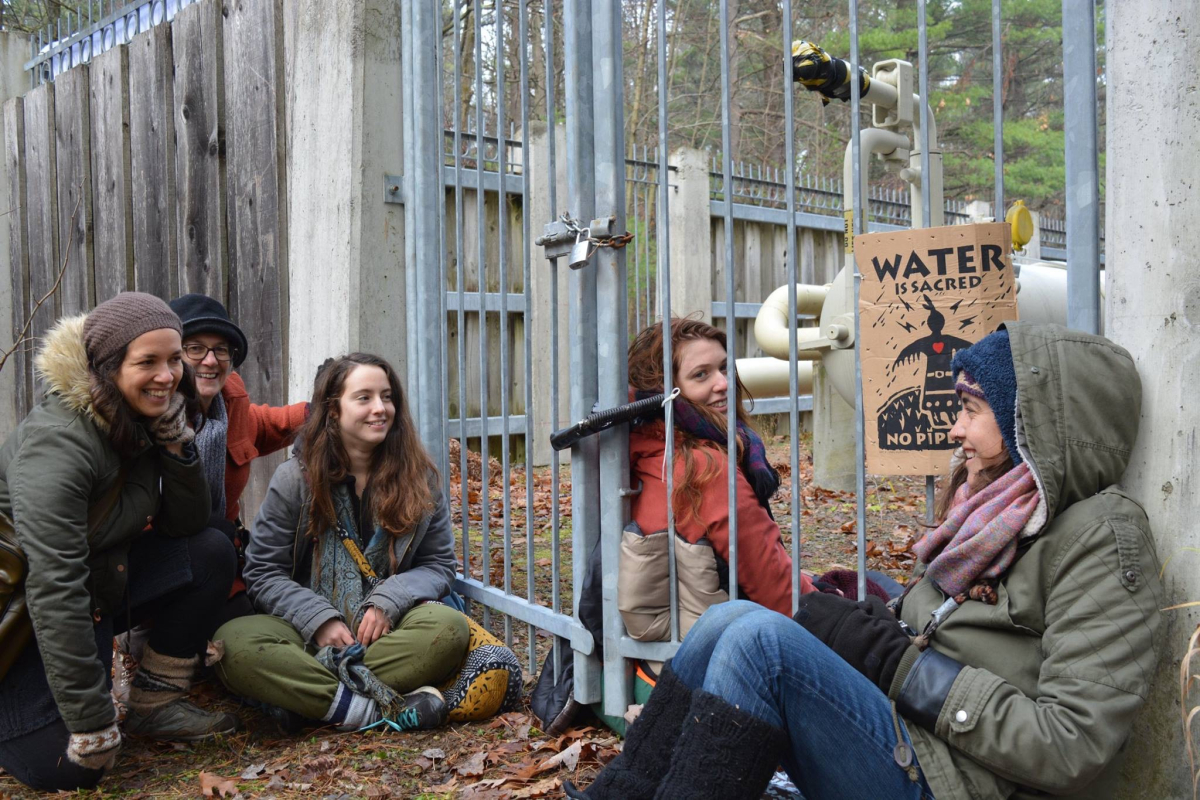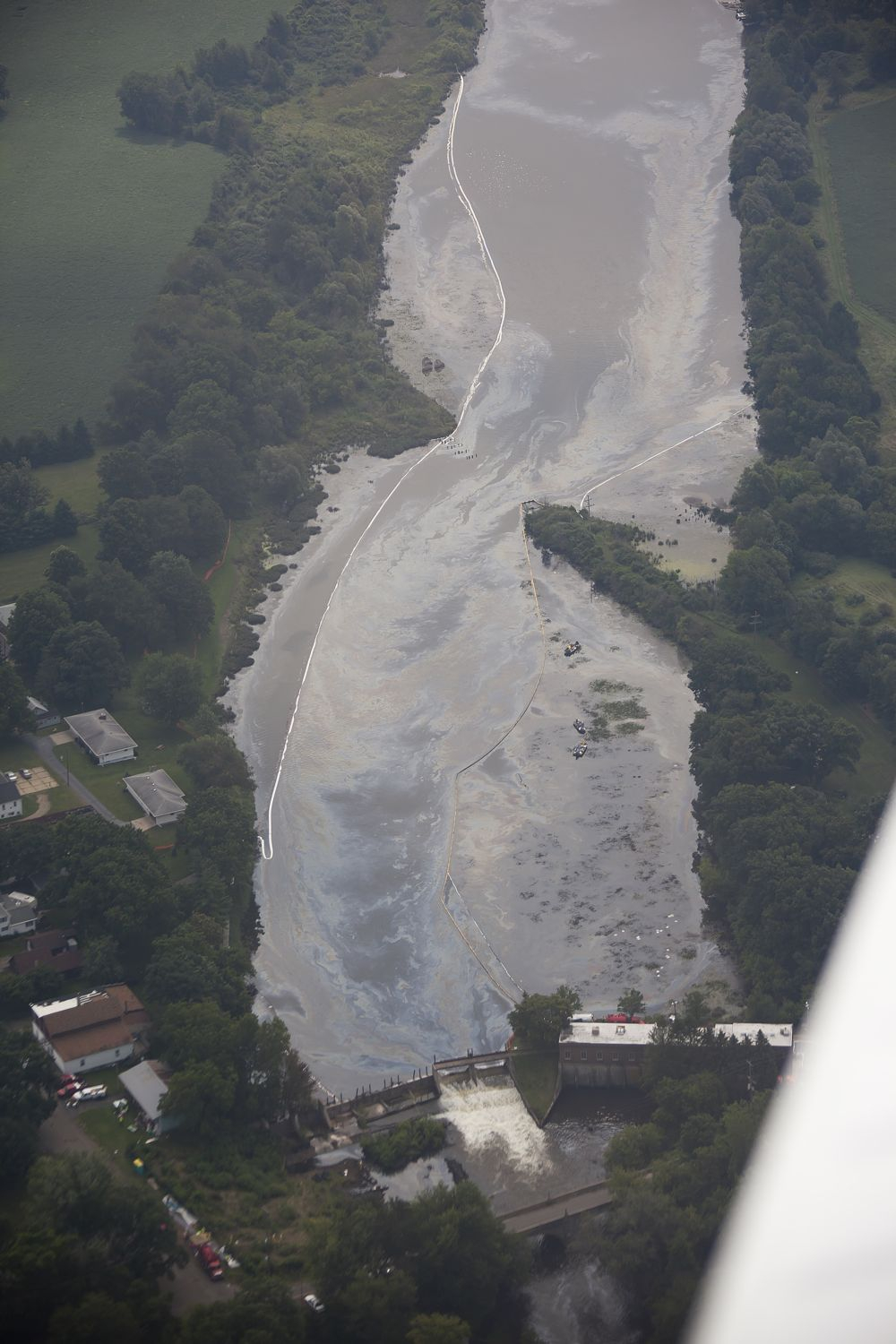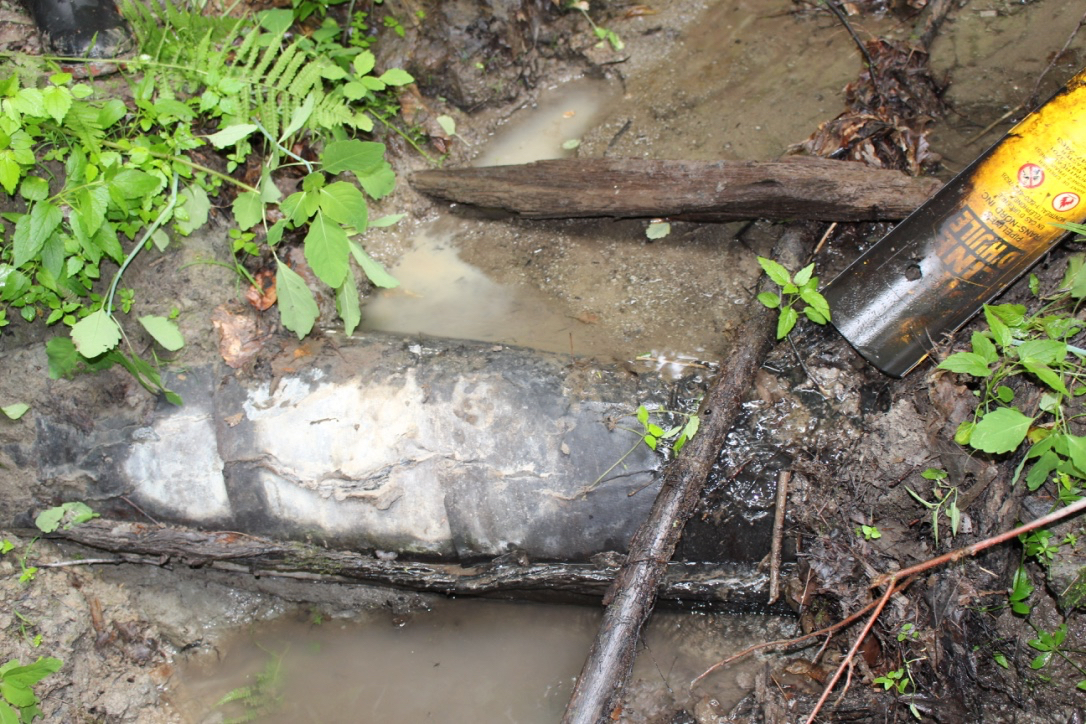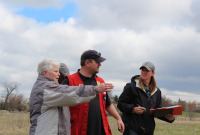Support strong Canadian climate journalism for 2025
Sylvie Rozon and Guy Coderre had just finished preparing a report on the threat of oil contamination in the Montreal region's drinking water when they decided to investigate a potential risk. It turned out to be serious.
Rozon and Coderre are teachers at a training school for water treatment infrastructure workers, and they had submitted their report to the Bureau d'audience publiques sur l'Environnement (BAPE), a government organization that conducts public hearings to investigate the impacts of industrial projects.
They went to visit land owned by Rozon's parents to look into how pipeline companies were taking care of their infrastructure.
Rozon's parents had bought the land, in Saint-Lazare, a town about 50 kilometres west of Montreal, in the 1990s. They only realized later that the land was on the path of the Trans-Northern pipeline, an aging and leaky line that has been carrying oil between the Montreal region and southern Ontario since 1952.
The Trans-Northern pipeline supplies jet fuel to major airports in Montreal, Toronto and Ottawa and in recent years, it has been plagued by safety problems that have prompted several interventions from federal pipeline safety enforcement officers.
“We were curious to go walk along the pipeline and that’s when we found—while walking—the pipeline (sticking) out from the ground. (It was) a segment of between four to five feet in a ditch and we could see it very well,” said Coderre.
It was June of 2016, and as they walked in a wooded area they found that part of the pipeline was sticking out. The exposed pipeline was in a ditch, suspended above a stream about four kilometres away from the Ottawa River, which is a source of Montreal's drinking water.

Rozon called Trans-Northern Pipeline Inc. to warn them about what they found. At first, an operator told them there was nothing unusual going on. But she pressed the company to investigate, she said.
Half an hour later, Jean-François Bisonnette, a supervisor at the company, called back to say it was not normal for the pipeline to be exposed, but that it wasn't dangerous. He said someone would come to inspect it.
Pipelines are commonly buried underground for safety reasons. Parts that are above ground require special protection from the elements. Pipeline failures can be caused by erosion or from being struck with force (by heavy machinery for instance), according to the federal regulator, the National Energy Board (NEB).
Operators are required to notify the NEB of any instance in which a pipeline is operating beyond its design limits, and this would normally include any instance of a pipeline sticking out above the ground in a spot where it's supposed to be buried.
“Mr. Bisonnette called me back to say he would come in the coming days to see this but that there were no dangers. But even if I kept saying it was not normal—there’s a water stream almost below—he said I was worried for nothing,” said Rozon.
They also contacted the city of Saint-Lazare as well as people from Citoyens Au Courant, an organization that advocates for pipeline safety and opposes dangerous projects. They also called journalists from TVA and Radio-Canada, Quebec's two largest news broadcasters.
“After TVA and Radio-Canada came and the story made headlines, it’s clear that at Trans-Northern they hurried up with a team to carry sacks of rocks, walking over maybe half a kilometre. They covered the pipeline with a rubber carpet of about two centimetres and put rocks on top of it.”
But Rozon said the stream of water swept away the rocks over the summer, leaving the pipeline covered only by a rubber carpet for the entire winter.
In the spring, the pipeline company came back to put more rocks over the pipeline, this time with a bulldozer. But after a few weeks, the water stream again pushed the rocks a few meters away, she said.
A year after her discovery, there is still no permanent solution for safeguarding the pipeline, Rozon said, and this concerns her.
The company said in an email they are in the process of securing permits from multiple local and provincial authorities such as the Environment Department and the Commission de Protection du Territoire Agricole (CPTAQ) to complete the permanent repair work. They added that municipalities, including the city of Saint-Lazare, have to review their application before sending it themselves to the commission, which will then examine their request.
“In the meantime, consistent with our commitment to ensure the safety of the community and to protect the pipeline, we visit the site regularly, including after significant rain falls, to visually inspect the area and ensure the site and the pipeline are safe," said Trans-Northern, in its email.
They stated they are in regular contact with the City of Saint-Lazare’s officials and provide updates to the area landowners.
The mayor of Saint-Lazare, Robert Grimaudo, confirmed he was in touch with Gail Sharko, manager of Trans-Northern's regulatory and external affairs, and said the pipeline company was easy to work with and very cooperative.
“The reality is that it’s the Quebec (government departments) that are causing all the delays,” he said. “Before a pipeline company can do the work, because there’s a stream right nearby, they need authorization from the ministry of the environment, the ministry of public security and so on and so forth, which of course, they haven’t (released) yet. The problem is the pipeline company is ready to go.”
The mayor warns that the situation shouldn't be “blown out of proportion.”
“There is no leak, there is no danger, there is no problem,” he said.
But Rozon, Coderre and the members of Citoyens au Courant disagree.
"If the pipe breaks, the water stream, which is right under, is four kilometres away from the Ottawa River," said Rozon, who fears millions of litres of oil could be spilled before it's noticed or stopped. "Since the land is made of clay, there could be a landslide, if a tree falls straight onto the pipe and breaks it, how long is it going to take for (someone from the company or residents) to see it? And the first valve to isolate the pipe when, say, they’ll know there’s a leak, is 40 kilometres away."

If a tree falls on a pipeline
Coderre, her co-worker, has trained employees to work in water filtration plants in the greater region of Montreal for 20 years. He was also a manager at one of the plants for 10 years. He said he thinks a leak could contaminate the Ottawa River, disrupting the Montreal region's drinking water supply within hours.
He recalled the July 2010 disaster in Marshall, Michigan when an Enbridge pipeline ruptured, spilling more than three million litres of crude oil into the Kalamazoo River. It took the company 17 hours to shut down its valve and the river was contaminated over 60 kilometres away from the source of the spill, according to subsequent investigations.
“I am surprised to see how little this (problem) is taken into consideration because as we are speaking today, a tree falling… could easily rupture the pipe, which is operating under very high pressure," he said. "There could be major consequences."
Sharko said they are confident the temporary repairs are protecting the pipeline.
"The repair method has been certified by an engineer, and is well recognized by the industry to address situations such as this. And, because we remotely monitor the pipeline should that situation ever change, we can shut down the pipeline remotely," she wrote in an email.
Darin Barter, a spokesperson for the NEB, said in an email that a falling tree was unlikely to rupture the pipeline and that tests are done so that pipelines "are capable of withstanding significant impacts and external pressure." However, he said, the section of the pipeline should not have been exposed and the NEB was taking this matter very seriously.
The regulator has already warned Trans-Northern several times that it wasn't operating its pipeline safely. The regulator issued several safety orders requiring the company to reduce its operating pressure, which would reduce the flow on the line that can carry up to 172,900 barrels of refined fuel products every day.
Overpressure incidents can cause failure of pipelines systems and are recorded and closely tracked according to the NEB. The regulator added that this information about incidents was available to the public.
A new safety order in September 2016 by the NEB noted Trans-Northern “has not satisfied all conditions set out in those Safety Orders and has had 11 overpressure incidents since 2010. While at no point did these incidents lead to public or environmental risks, their recurrence demonstrates to the NEB that (the company) has not yet effectively resolved its overpressure hazard.”
While a majority of the regulator's members agreed to allow the company to pursue its operations in September 2016, there were two dissenting voices on the Board, James Ballem and Mike Richmond, who said the pipeline should be shut down. Ballem and Richmond said the company had six years to comply with numerous safety orders but failed to do so.
Barter said in an email they are monitoring Trans-Northern’s progress as it develops a permanent solution at Saint-Lazare. In their recording of the incident, the regulator categorized the event as "geo-technical, hydraulic or environmental activity threatens the safe operation of a pipeline" and "operation beyond design limits" and described it as "exposure in a waterbody."
The company is required to submit a proposal of its repair work for approval to the NEB. Barter told National Observer last month that it was expecting this application from Trans-Northern by early August. But it has still not received the formal application, and Barter now says the NEB expects something by the end of August.
He added that NEB staff are also actively monitoring the company’s compliance with the emergency safety orders by meeting with them, doing field inspections and requesting information.
Quebec's Environment Department said it has also been following the situation in Saint-Lazare closely and dealing with Trans-Northern Pipeline Inc.
The provincial department sent a warning letter in July 2016, noting that it had failed to get authorization for its initial maintenance work that consisted of covering the exposed pipeline with a rubber carpet and some rocks.
Warning letters of this nature typically warn companies when they are violating the law and facing legal or administrative consequences, including fines.
A request for a certificate of authorization for temporary works was submitted thereafter which the Ministry granted on March 22, 2017.
On June 7, 2017, the Ministry released a new non-conformity notice stating “the size of rocks used and the surface planned for the rocks did not conform and the company omitted to do bank sloping work.” The rocks used by Trans-Northern were smaller than what the March 2017 permit asked for and this "could have an impact on the durability of the works," explained Clément Falardeau, communications director at the Environment Ministry.
Additionally, the area of repair was bigger than what was stated in the permit and Trans-Northern did not do bank sloping work as was required, the Ministry noted in a following inspection.
“The department is reviewing the different legal recourses possible following this second non-conformity notice,” said Daniel Messier, communication advisor and regional spokesman for the provincial department.
He said Trans-Northern had yet to submit a request of a certificate of authorization for a permanent solution, which the department will then analyze.
For Coderre, Rozon and les Citoyens au Courant, the way the situation is being handled is very opaque and has so far excluded citizens.
“We feel a bit powerless, there are no consultations regarding Trans-Northern pipeline, there’s really nothing we can do, we have access to no results and we don’t know what tests have been done on the pipeline.It’s a bit mysterious,” said Katherine Massan, of Citoyens au Courant. “Our group finds it worrying.”
They also think the process to fix the situation has been very slow.
“(Trans-Northern engineers) are very nice, extremely polite but everything is always good, life is beautiful, smile, everything is under control, is safe, but they never do anything,” said Rozon.
Sharko says Trans-Northern understands and appreciate that local residents "may want us to move more quickly but (the pipeline workers) need to make sure that (they) do the work safely, with the required permits in place."
This is the second time Rozon has seen a segment of an exposed pipeline on her family’s land. After her father had bought the land, she said he encountered a similar situation in 1995.
“They put rocks on it and a sort of big metal grille attached to the banks. Nothing has moved since 1995… it’s strong, it’s maintained.”
She says this could be a solution, but it’s up to Trans-Northern and government stakeholders to fix the exposed pipeline as fast as possible before anything happens.
“Often, the pipelines which broke are the one(s) that were across rivers because with the water rising, it washes away the rocks going over the pipe and under it as well, and if the pipe is suspended instead of being supported on something solid, that’s when pipes become more vulnerable.”






Comments
This leaky old and decrepit pipeline will continue to operate as long as the NEB keeps turning a blind eye to its ignored safety orders and calls to shut it down by two of its own board members.
Trans Northern has a complacent lack of concern on inadequate depth of cover and an aging pipeline in extremely bad condition.
The NEB's laissez-faire attitude to the company's failures perpetuates Trans Northen's butt dragging. Government departments may ask that Trans Northern do things the correct way, and the company balks, causing delays.
Trans Northern's pipeline has had numerous incidences of leaks across Quebec and Ontario, dating from as far back as the 1960s, which has left a path of historical contamination across both provinces.
These locations have NOT been remediated, and the many affected landowners have NOT received compensation for their lands contaminated by Trans Northern. These landowners are left with, essentially, worthless deserted gas stations on their properties.
It's obvious who controls the NEB and the safety of the environment regarding pipeline operations.